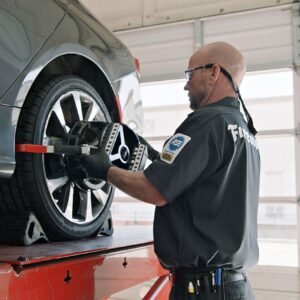California’s diverse climate, ranging from coastal cool to hot inland deserts, requires careful thought when choosing the right tires for your vehicle. Whether you’re navigating the wet roads of Northern California or driving through the hot, arid conditions of the South, selecting the best tires for California is essential for safety, comfort, and optimal vehicle performance. In this article, we will explore the different tire types suited for California’s varying weather conditions, offering a guide to making the best choice for your vehicle.
Discover why the Hyundai Kona is a top choice for 2024
Why Tire Selection is Crucial for California Drivers
Selecting the right tires for your vehicle is crucial to ensure optimal performance, safety, and longevity. California’s climate presents a unique set of challenges for drivers, from heavy rain in the northern parts of the state to scorching heat in the south. Tires are your vehicle’s only point of contact with the road, and choosing the wrong ones can lead to poor handling, reduced fuel efficiency, and increased risk of accidents. Understanding the specific weather patterns in different regions of California will help you make a more informed decision.
Best Tires for California: Understanding the Local Climate
California’s climate varies significantly across the state, so the best tires for California depend on where you live and the typical weather conditions you’ll encounter. For instance, the northern part of the state receives more rainfall and may require tires that perform well in wet conditions. In contrast, the southern parts of California experience high temperatures, so tires that can handle extreme heat and provide high performance are necessary. Let’s break down the best tire types for different conditions.

Tires for Rainy Weather California: Maximizing Traction and Safety
In Northern California, where rainy weather can be frequent during the winter months, selecting tires that perform well in wet conditions is essential. Tires designed for rainy weather offer deep treads and special rubber compounds that improve traction on wet roads, reducing the risk of hydroplaning. Look for tires that are specifically labeled as “all-season” or “rain” tires, as they are designed to handle both wet and dry conditions effectively.
When choosing tires for rainy weather in California, consider the following factors:
- Tread Pattern: Tires with deeper grooves and a more aggressive tread pattern help channel water away from the tire’s surface, providing better grip.
- Rubber Composition: Soft rubber compounds are ideal for wet roads as they remain pliable, maintaining better traction in rainy conditions.
- All-Season Tires: If you experience moderate rainfall, all-season tires may suffice. They perform well in both rain and dry conditions, offering versatility year-round.
Tires for Hot Weather California: Durability and Performance
In Southern California, high temperatures can be a concern, especially during the summer months. Tires designed for hot weather conditions are built to withstand the heat, providing excellent performance while minimizing wear and tear. Hot weather tires feature a tougher rubber compound that resists heat degradation, ensuring longer-lasting durability. These tires are also designed to maintain traction and handling even in extreme temperatures.
When choosing tires for hot weather in California, consider the following factors:
- High-Performance Tires: High-performance tires are designed to provide superior grip and handling at higher speeds, which is ideal for California’s fast-paced driving environment.
- Temperature-Resistant Rubber: Tires with a heat-resistant rubber compound help prevent premature wear, ensuring a longer lifespan even in hot conditions.
- Summer Tires: Specifically designed for high temperatures, summer tires offer the best handling and performance in dry, hot weather but are not suitable for wet conditions.
All-Season Tires: A Versatile Option for California Drivers
All-season tires are one of the most popular choices for California drivers due to their versatility. These tires are designed to perform well in a variety of weather conditions, including light rain and moderate heat. All-season tires have a balanced tread pattern that provides decent traction on both dry and wet roads, making them suitable for drivers who experience mild to moderate weather changes.
All-season tires are ideal if:
- You live in an area with moderate temperature fluctuations.
- You want a balance between traction, durability, and fuel efficiency.
- You do not frequently encounter extreme weather conditions like heavy rain or intense heat.
The Importance of Tire Maintenance in California
Regardless of the type of tires you choose, regular maintenance is crucial for ensuring their longevity and performance. In California, where temperatures can fluctuate significantly, it is especially important to keep your tires properly inflated, check for signs of wear, and rotate them regularly. Proper maintenance helps improve fuel efficiency, extend tire life, and enhance safety on the road.
Here are some tire maintenance tips for California drivers:
- Check Tire Pressure Regularly: California’s hot weather can cause tire pressure to fluctuate, so it’s essential to check your tire pressure regularly and adjust it as necessary.
- Rotate Your Tires: To ensure even wear and maximize the lifespan of your tires, rotate them every 6,000 to 8,000 miles.
- Inspect for Damage: Examine your tires for signs of cuts, punctures, or bulges, and replace them if necessary to avoid potential blowouts.
Conclusion: Choosing the Right Tires for California’s Diverse Conditions
When it comes to selecting the best tires for California, understanding the local climate is essential. For rainy weather in Northern California, tires designed for wet conditions with deep treads and soft rubber compounds will provide the best performance. In Southern California’s hot weather, high-performance tires with heat-resistant rubber are ideal for maintaining durability and handling. All-season tires offer versatility for drivers in regions with moderate climates.
Learn about the Toyota Yaris features and performance now





